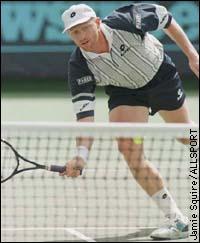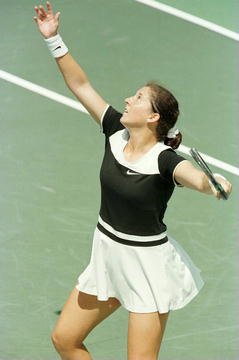<% ns_puts [mkm_getnavbar] %>
What's Weird About Coaching in Tennis...or Should I Say Unique?
What has always struck me about tennis is how weird it can be, or
unique depending on your point of view, especially in regard to coaches
and coaching. The quirks associated with coaching are magnified at a huge
event like the US Open. Here is a list of the top quirks associated with
coaching in profession al
tennis.
al
tennis.
Anyone can become a coach. If your dream has always been to be a big time coach, tennis is your hope. In no sport are there as many coaches of dubious origin and background as tennis. The phrase "a sucker is born every minute" aptly applies to many tennis players who have fallen victim to slick talkers with eclectic resumes including notables such as Boris Becker who stated that one of his coaches cost him at least one year of his career, meaning, he would have won quite a few more titles with a "better" coach.
Tennis Players Seem Especially Vulnerable
Unlike other sports where large organizations are in charge, tennis can be very open, with players often being quite accessible especially early in their careers. So if you have an in and a good line, who knows, you might someday coach the next number one in the world - others have. Rarely (which would be unheard of when applying for a head coaching job in another sport) will a player ask for a resume, so it won't matter what you did in the past or are doing now. The main thing is that you are persuasive. Once you are in, you'll be a coach by default or association, without ever getting a certificate or knowing what's it's like to face match point in a big tournament. In no time at all newspapers will label you as a coach, perhaps even a psychologist, so long as you are seen with a player. Better yet of course is that you hang on a while and, perhaps as those fortunate few, will actually latch on to a winner. If so, you'll get all the credit.
|
Here is a brief list of notable coaches, parents included and what they did prior to latching on to their ticket to fortune and fame.
- Gunther Bresnik: coached numerous players including Pat McEnroe and Boris Becker, who at the end of their relationship labeled this former student (Bresnik) as incompetent. By student I mean this person actually set out to be a coach before he even knew how to play tennis himself. He essentially hired a tennis teacher to teach him how to coach parallel to learning basic strokes. In a matter of a year his gift of gab and persuasion endeared him to a host of journeymen players who hired him. Eventually Bresnick became Captain of the Austrian Davis Cup team thanks to Boris Becker. Image is everything. Today he coaches Stefan Koubek and could be seen on the grounds of the US Open.
- Ronnie Leitgeb: Thomas Muster's coach used to be a journalist. Talk about being friendly with the media! Muster propelled Leitgeb to the top of the tennis world in Austria where his word is now gospel. Leitgeb learned the ropes from W. Fibak the former Polish great. Like Bresnik he barely can hit the ball. Both have never played a tournament match.
- Richard Williams and Jim Pierce: Two examples of many tennis parents who made their offspring into stars. I might add that I have much more respect for parents who have devoted their lives and resources to actually develop their child(ren) into top players than those coaches who more or less talked their way into an already developed player's life. Rarely has a coach like Leitgeb or Bresnick gone on to produce a top player on their own. To me that is the real test. These two coaches have argued that their talent lies in the ability to take a player to a new level, implying that previous coaches who actually developed the technical and tactical game of players they now coach would not have been able to advance a player's career beyond a certain point. That is a self-serving argument having little merit. I'd venture to say without getting their big break at least these two star coaches of erstwhile would still be teaching beginners or begging players for interviews as they once did.
Currently, the Austrian tennis scene is in chaos with many qualified coaches and administrators who were seduced and/or blackmailed into sharing the power with these rogue coaches, shocked at the state of the budget and results of player development efforts under the auspices of these coaches. (Both manipulated federation budgets and threatened to withdraw their players if they did not get their way).
All I can say to this is, please federations, associations, and players, beware of falling for fast talkers and start paying attention to those coaches who for years have done the real developmental work in the trenches.
|
Why is it that coaches don't have their own seat at tournaments?
I think it's ridiculous that coaches usually don't know where they are going to sit prior to a match. Oh, they may have a general idea where they'll sit, and yes, there is a player's and coach section at most courts. Nevertheless, coaches do not have a specific reserved area like the Davis Cup captain does (his own bench). I've seen coaches jockey for a seat, have to beg an usher to let them go to their seat, have to sit next to strangers and respond to questions during a match.
I've even worked with more modest coaches who were too polite to ask for a seat in a full stadium. To top things off, what's with these live interviews with a coach in the middle of a point. Could you see that happening in football or basketball, O.K., I'll accept a coach who is "miked" for TV but don't like the idea of midpoint interviews. The way coaches are treated in tennis is very unprofessional.
Why Can't Coaches Coach During Matches?
This topic has been beaten to death but I had to list it anyway. I'm all in favor of some sort of coaching. At least that way a coach would be assured of a seat. Coaches would be highly visible to TV. They could also wear a mike. If they are not allowed to constantly coach they should at least be able to coach at the end of a set, or prior to a tiebreaker.
Coaching would also put an end to elaborate signaling schemes that go on in tennis, oftentimes involving third parties the umpire can't penalize. Coaching would go a long way toward making matches more competitive, especially one-sided blowouts. Good courtside coaching could help a struggling player immensely.
Why are Coaches Always the Scapegoat?
Here are major offenders. Players who dump coaches left and right or have a poor record when it comes to paying players in no particular order. These players would be wise to look what happens to players who have long-term and stable relationships with their coach:
Coach Friendly Players: Sampras, Krajicek, Agassi, Kuerten, Tauziat, Graf
Coach Unfriendly: Haas, Kiefer, Agenor, Seles, Rios, Pierce
Your comments are welcome. Let us know what you about think this article by emailing us here at TennisONE.
Dr. Roland A. Carlstedt has followed the professional
tennis tours since 1985, fulltime from 1989-1998 in which he on average
attended 25 tournaments a year including all Grand Slam events and
important Davis Cup ties. During this time he complied perhaps the most
extensive database in existence on the psychological performance,
tendencies, and profiles of most ATP and WTA players. His annual
Psychological World Rankings for Tennis have been published since 1991
more than 500 times in over 40 countries. His rankings and data are based
on his Psychological Observation System for Tennis. Interestingly his 2000
rankings which were released prior to the 2001 Australian Open had 2 of 4
semifinalists and 8 of 16 quarterfinalists on them including such unlikely
players as Arnaud Clement and Sebastian Grossjean. His 2001 rankings will
appear in TennisONE at the end of the year.
Last Updated 8/31/01. To contact us, please email to: webmaster@tennisone.com
TennisONE is a registered trademark of TennisONE and SportsWeb ONE; Copyright 1995. All rights reserved.


